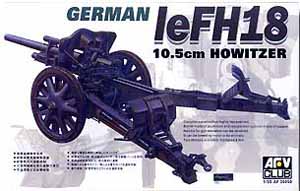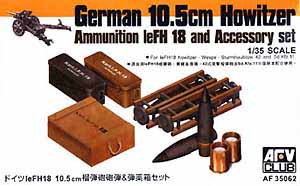AFV Club's 1/35 German leFH18, 10.5cm Howitzer Kit No. AF35050
MSRP: $31.68 |  | History: The German Army command asked for improvement of the light field howitzer 16, which had been in use in World War One. The answer, which the Rheinmetall Company came up with, was the leFH18. Overall an orthodox design, it had the same 10.5cm calibre as its predecessor, with a barrel length of 2941mm (9.65 ft.), and used a split trail with folding spades and a hydro-pneumatic recoil system. Its base could be fitted with either wooden or pressed-steel wheels (the kit has the steel ones), and it was designed to be towed by horse-drawn wagon as well as wheeled or half-track vehicles. (you get these variant options in the kit). The leFH18 proved to be a sound design with both reliability and accuracy. It served widely in many artillery regiments throughout WWII, forming the backbone of German divisional field artillery. The leFH18 used separate war-head and propelling charges, between one and six of these charges depending on the desired range. However, its maximum firing range of only 10,675m (11,674.3 yds.), made it no match for its Soviet counterpart. Its heavy weight also made it unable to be truly mobile, often resulting in it being abandoned in the muddy terrain of the Russian front. When first confronted with the Soviet T-34, KV-I and KV-II tanks in 1941, German anti-tank weaponry was quickly found to be inadequate. One of the only guns capable of destroying these Soviet tanks was the leFH18. In these instances, however, it had to be operated with direct firing. With a short a short gun breech travel distance, during firing, it could also be mounted on self-propelled vehicles after certain degrees of modification. With a total of 4,845 in service by 1939, leFH18 not only served the German Army at all fronts during the war, but was also kept in service by several European armies for some years after the war ended. What's in the box? The kit comes in a sturdy tray and lid type box. The box art shows a leFH18 in the firing mode. A side panel shows a painting of one being towed by a SdKfz. 11 half-track (AFV Club markets three different kits of this vehicle). There is also a head-on painting of one in a red-brown camouflage pattern over a earth yellow base. Inside the box lid, on all four sides, there are reproductions in color of the box arts for 12 other armor kits in the AFV product line. The bottom of the tray repeats this, in black and white, for 16 more kits. So, the inside of the box is a virtual catalog for AFV kits. Nice touch! There are four parts trees of sand yellow colored styrene parts, each in their own separate cello bags. Inside the smallest cello bag is a postage-stamp sized decal sheet, a turned aluminum gun barrel, a copper tube (to be used for the guns recuperator cylinder), a black vinyl tube that is ribbed (to be used to represent a coil spring), and the smallest styrene tree. Medium sized tree, letter "A", holds: the gun shield, trunnion holding side pieces, elevation and traverse wheels, a pick axe, trail arm lengths, breech parts etc. (50 parts). Large sized tree, letter "B", holds: pressed-steel type wheels, tires, axles, suspension parts, shovels, and numerous other small fittings (56 parts). Another medium sized tree, letter "C", holds: the folding ground spades, more trail arm lengths, and other small fittings (23 parts). The smallest tree, letter "D", holds: 2 shovels, a maul, another pick axe, a regular axe, gun sight parts etc. (12 parts). Finally, there are the turned aluminum barrel, the copper tube, vinyl spring piece, and the small decal sheet. The instruction sheet is 8.5" x 11" format, of 12 pages. This is a stapled booklet with 15 assembly steps. Colors for the howitzer are called out in Gunze Sangyo, Humbrol, Revell, and Life Color brand paints (I have never heard of Life Color before, have you?). There is a history of the weapon given in English, Chinese and Japanese. The bottom of page 11 gives painting and decaling instructions. It calls out either an overall German gray or dark yellow paint schemes. The decal sheet includes the nick-name "Braun", that goes on the side of the rear end of the gun barrel and on the front of the gun cradle. Surprisingly, the two color camouflage scheme shown on the side of the box lid is not shown on the instruction sheet. The 12th page of the instructions has parts tree drawings, followed by parts replacement forms, that can be mailed to AFV to get any missing parts.  There are no crew figures supplied or any rounds of 10.5cm ammunition. AFV Club has a kit of the ammunition and its shipping crates that is sold seperately. It is kit No. AV35062 and Greatmodels has it for $13.75 from them. The aftermarket armor accessory company, that I own and manage: Armor Research Co. also has the 10.5cm two-part ammo. It is product No. AR2024. You can get 10 white metal rounds from me for $5.00 + postage. I will add one or two of my sets to this kit. I would have prefered to have seen a few rounds in this kit and a gun crew. Oh well! There are no crew figures supplied or any rounds of 10.5cm ammunition. AFV Club has a kit of the ammunition and its shipping crates that is sold seperately. It is kit No. AV35062 and Greatmodels has it for $13.75 from them. The aftermarket armor accessory company, that I own and manage: Armor Research Co. also has the 10.5cm two-part ammo. It is product No. AR2024. You can get 10 white metal rounds from me for $5.00 + postage. I will add one or two of my sets to this kit. I would have prefered to have seen a few rounds in this kit and a gun crew. Oh well! Conclusion Parts are crisply molded and without any flash. Ejector pin marks are kept to a bare minimum also. I did not detect any sink marks either. Overall, a good job of molding! The kit can be assembled in the towed mode (either horse or vehicle towed) or in the set up/firing mode. The main tow vehicle was the Sd.Kfz. 11. As I said earlier, AFV offers this in three different kit offerings. However, if you want to do a horse-drawn version you will have to scrounge up a horse team somewhere. With a grand total of 144 parts in this kit (a gross), and some of its teeny parts (not to mention its complexity), I would only recommend this to the advanced armor modeler. The box says for 14yr olds on up. Use care with those teeny parts, so that the plastic eating shag rug monster does not get them. I bought my kit at the local hobby shop. | 








|

 There are no crew figures supplied or any rounds of 10.5cm ammunition. AFV Club has a kit of the ammunition and its shipping crates that is sold seperately. It is kit No. AV35062 and Greatmodels has it for $13.75 from them. The aftermarket armor accessory company, that I own and manage: Armor Research Co. also has the 10.5cm two-part ammo. It is product No. AR2024. You can get 10 white metal rounds from me for $5.00 + postage. I will add one or two of my sets to this kit. I would have prefered to have seen a few rounds in this kit and a gun crew. Oh well!
There are no crew figures supplied or any rounds of 10.5cm ammunition. AFV Club has a kit of the ammunition and its shipping crates that is sold seperately. It is kit No. AV35062 and Greatmodels has it for $13.75 from them. The aftermarket armor accessory company, that I own and manage: Armor Research Co. also has the 10.5cm two-part ammo. It is product No. AR2024. You can get 10 white metal rounds from me for $5.00 + postage. I will add one or two of my sets to this kit. I would have prefered to have seen a few rounds in this kit and a gun crew. Oh well! 







